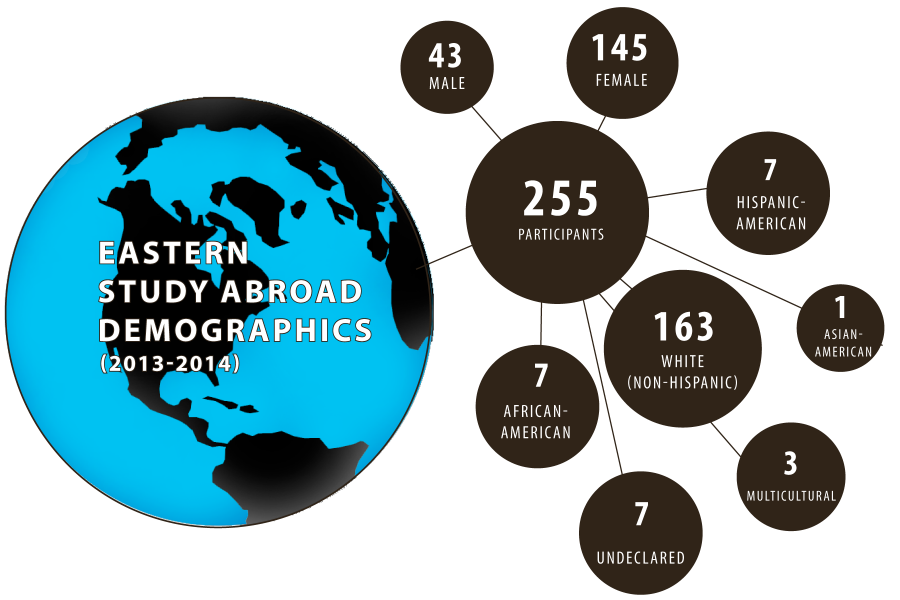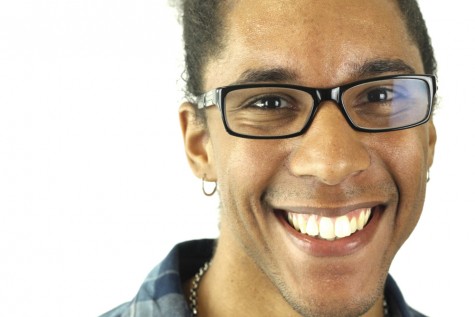Study abroad lacks in gender, minority representation locally, nationally
March 9, 2015
Eastern’s ethnic minorities represent 18 of the 188 students enrolled in study abroad for the academic school year of 2013-14.

Kurt Olausen, the director of study abroad, said he was unsure why the numbers for minorities in Eastern’s study abroad program had so many outliers.
“God, I have no explanation for that. None at all,” Olausen said.
Nationally, African-Americans make up 5.3 percent of students studying abroad, while Latinos are 8 percent and Asians are 7 percent. This can be compared to Caucasians, who are more than 75 percent, according to the 2012-13 Institute of International Education open doors data.
Specifically, African-Americans were the largest minority group to participate in Eastern’s study abroad, with as many as 26 going.
Olausen said one of the theories he has heard, which would make study abroad more ideally adaptable for minority students than Caucasians, is the notion of their ability to straddle the line of the two cultures.
Another theory is called the “Four F’s”: family, friends, finances and faculty.
“Minority students may not have family support, their friends aren’t doing it so therefore they don’t want to take the chance, they don’t think they have the finances, and faculty may not be as encouraging to minority students as they are white students,” Olausen said.
Olausen said another “F” could be added to the theory, which is fear. Some minorities may wonder if they are going to experience racism or to be treated like a second-class citizen.
Glen Curry, a senior pre-pharmacy major, said he had a good experience when he went to China and was supported by his family. Curry said he went for a program that teaches students about how the Chinese use plants for medicine.
Curry, who was the tallest person standing at 6-feet-5-inches, and one of two African-Americans on the trip, said everyone got odd looks in the group.
Curry said the Chinese would always talk about his height and asked to touch the black girl’s hair because it was in braids.
“I guess they were fascinated by it,” Curry said.
When it comes to Olausen’s “Four F’s,” Curry had a different take on the theory. Curry said his family supported his trip, as well as the faculty who traveled with him. Because he figured this would be the only time he could leave the country, he took in everything he could.
One scholarship exists for underrepresented students interested in the program called the Benjamin Gilman Scholarship, which aims at Pell Grant eligible students with the goal of diversifying study abroad.
Olausen, who said he dislikes the fact that the numbers for minority students are so low within the program, said comments from return students who are the program’s greatest asset for attracting others, could also be the worst. However, he is unsure if bad word of mouth is the reason for the steady decline in study abroad by African-Americans.
“No one in any branch of higher education wants to just educate upper middle class white people—that’s not what we’re about,” Olausen said.
Olausen said one of the ways the program has attempted to reach out to other minorities is by talking to Minority Affairs, and he plans on having a panel during the next Diversity Conference.
A panel he would also like to see is one comprised of minority students who have participated in study abroad to show there are students like them who have done it, Olausen said.
Another distinct difference in the study abroad program is gender.
More than half of the students in the program are female.
Olausen said he had a few theories on why Eastern’s numbers are so heavily skewed toward one gender, which can be found in some historical context and even perceptions.
Olausen said historically, study abroad was seen as a “finishing” program for girls while they were in school. It was essentially their way of topping off their educational experience with a trip aboard because they may not ever get a chance to do it again.
Study abroad was also typically focused on degrees pertaining to arts and humanities, which also see mainly female students. When looked at comparatively to Eastern, the university has its origins in teaching and those students tend to be mostly women as well, Olausen said.
“We have a much starker contrast than national numbers,” Olausen said.
Women also outnumber men drastically nationally for studying abroad; women make up 65 percent compared to men, who make up only 35 percent of the program, according to the 2012-13 Institute of International Education Open Doors Data.
Olausen said for men, the theory was usually that many men felt they could eventually travel during their career, but also STEM (science, technology, engineering and mathematics) schools have begun to make a push for more of their students to study abroad.
Roberto Hodge can be reached at 581-2812 or rlhodge@eiu.edu.
















![[Thumbnail Edition] Senior Foward Macy McGlone, getsw the ball and gets the point during the first half of the game aginst Western Illinois University,, Eastern Illinois University Lost to Western Illinois University Thursday March 6 20205, 78-75 EIU lost making it the end of their season](https://www.dailyeasternnews.com/wp-content/uploads/2025/03/WBB_OVC_03_O-1-e1743361637111-1200x614.jpg)





















































